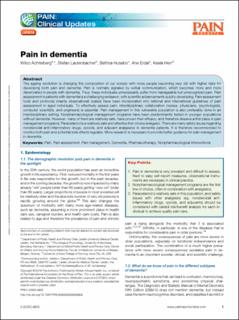| dc.contributor.author | Achterberg, Wilco | |
| dc.contributor.author | Lautenbacher, Stefan | |
| dc.contributor.author | Husebø, Bettina | |
| dc.contributor.author | Erdal, Ane | |
| dc.contributor.author | Herr, Keela | |
| dc.date.accessioned | 2021-05-03T12:54:09Z | |
| dc.date.available | 2021-05-03T12:54:09Z | |
| dc.date.created | 2020-11-26T11:59:08Z | |
| dc.date.issued | 2020 | |
| dc.Published | Pain Reports. 2020, 5 (1), e803-?. | |
| dc.identifier.issn | 2471-2531 | |
| dc.identifier.uri | https://hdl.handle.net/11250/2753300 | |
| dc.description.abstract | The ageing revolution is changing the composition of our society with more people becoming very old with higher risks for developing both pain and dementia. Pain is normally signaled by verbal communication, which becomes more and more deteriorated in people with dementia. Thus, these individuals unnecessarily suffer from manageable but unrecognized pain. Pain assessment in patients with dementia is a challenging endeavor, with scientific advancements quickly developing. Pain assessment tools and protocols (mainly observational scales) have been incorporated into national and international guidelines of pain assessment in aged individuals. To effectively assess pain, interdisciplinary collaboration (nurses, physicians, psychologists, computer scientists, and engineers) is essential. Pain management in this vulnerable population is also preferably done in an interdisciplinary setting. Nonpharmacological management programs have been predominantly tested in younger populations without dementia. However, many of them are relatively safe, have proven their efficacy, and therefore deserve a first place in pain management programs. Paracetamol is a relatively safe and effective first-choice analgesic. There are many safety issues regarding nonsteroidal anti-inflammatory drugs, opioids, and adjuvant analgesics in dementia patients. It is therefore recommended to monitor both pain and potential side effects regularly. More research is necessary to provide better guidance for pain management in dementia. | en_US |
| dc.language.iso | eng | en_US |
| dc.publisher | Wolters Kluwer | en_US |
| dc.rights | Navngivelse 4.0 Internasjonal | * |
| dc.rights.uri | http://creativecommons.org/licenses/by/4.0/deed.no | * |
| dc.title | Pain in dementia | en_US |
| dc.type | Journal article | en_US |
| dc.type | Peer reviewed | en_US |
| dc.description.version | publishedVersion | en_US |
| dc.rights.holder | Copyright 2019 The Authors | en_US |
| dc.source.articlenumber | e803 | en_US |
| cristin.ispublished | true | |
| cristin.fulltext | original | |
| cristin.qualitycode | 1 | |
| dc.identifier.doi | 10.1097/PR9.0000000000000803 | |
| dc.identifier.cristin | 1852757 | |
| dc.source.journal | Pain Reports | en_US |
| dc.source.40 | 5 | |
| dc.source.14 | 1 | |
| dc.identifier.citation | Pain Reports. 2020, 5(1), e803 | en_US |
| dc.source.volume | 5 | en_US |
| dc.source.issue | 1 | en_US |

